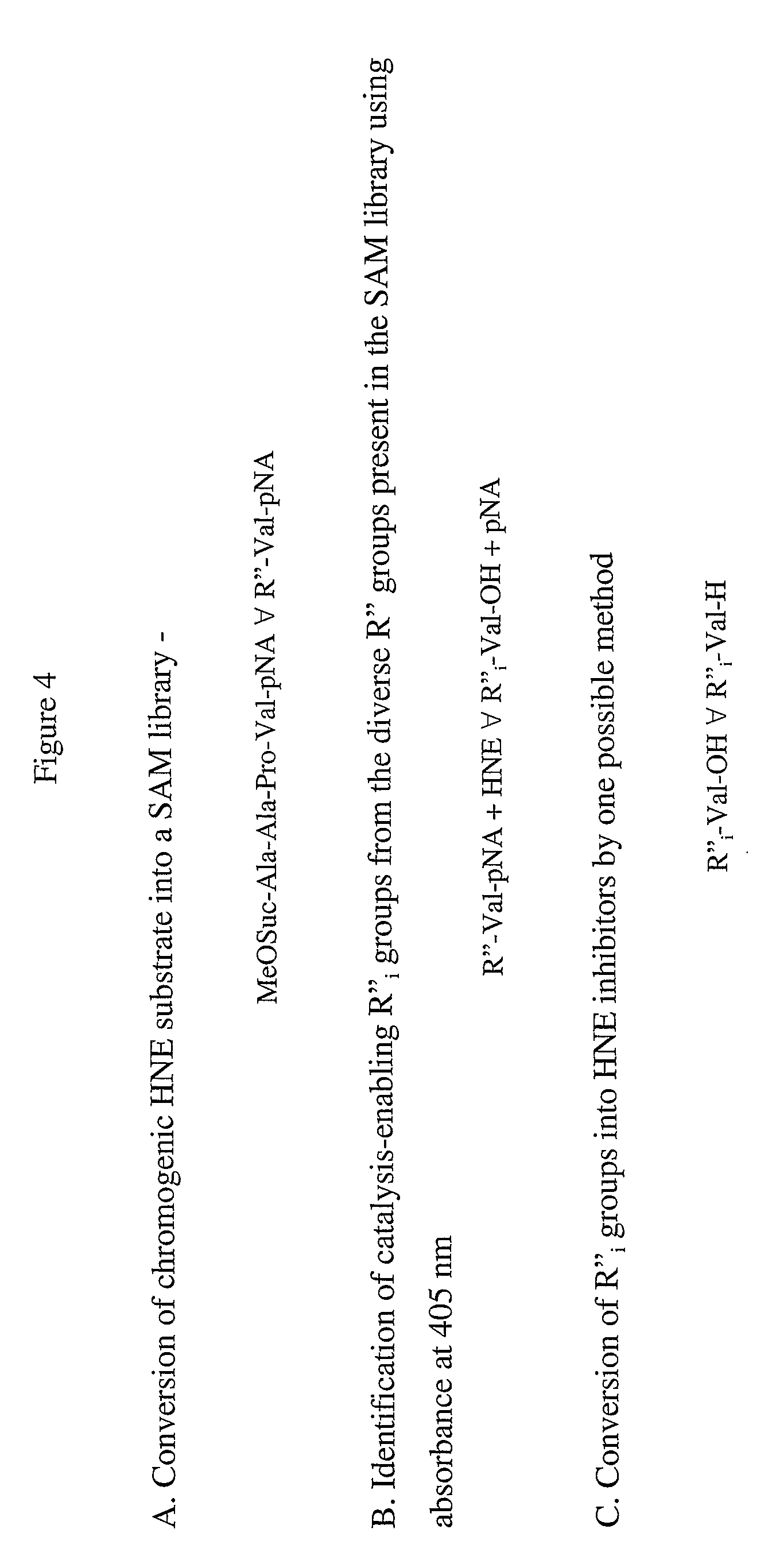Methods for identification of inhibitors of enzyme activity
a technology of enzyme activity and inhibitor, which is applied in the field of methods for identifying enzyme activity inhibitors, can solve the problems of low “hit rate” of screening strategies, difficult to achieve optimal drug discoveiy, and methods that do not appear to work well
- Summary
- Abstract
- Description
- Claims
- Application Information
AI Technical Summary
Benefits of technology
Problems solved by technology
Method used
Image
Examples
examples
[0715]The invention will be more readily understood by reference to the following examples, which are included merely for purposes of illustration of certain aspects and embodiments of the present invention and not as limitations.
example i
Synthesis of R-Arg-pNA Compounds
[0716]The following protocol was utilized for the synthesis of all compounds of the general form R-Arg-paranitroanilide (R-Arg-pNA), starting from R—COOH and H-Arg-pNA, utilizing resin-bound carbodiimide reagent (PS-Carbodiimide) and hydroxybenzotriazole (HOBt) (See FIG. 1). R—COOH were obtained from commercial suppliers (ASDI, Maybridge, U.K. or ASDI Biosciences, Newark Del.). PS-Carbodiimide was obtained from Biotage (Charlottesville Va.). H-Arg-pNA was obtained from either Bachem Bio Science Inc (King of Prussia Pa.) or Chem-Impex International Inc. (Wood Dale Ill.). HOBt was obtained from Anaspec (San Jose Calif.). Methylene chloride (DCM) was obtained from JT Baker (Phillipsburg N.J.). Dimethylsulfoxide (DMSO) was obtained from Pierce Chemical (Rockford Ill.). Diisopropylethylamine (DIPEA) was obtained from Aldrich (St Louis Mo.).
[0717]Aliquots of PS-Carbodiimide resin (100 μmols) were dispensed into inlet-closed, fritted, polypropylene cartridge...
example ii
Synthesis of R-(4-Bz) Compounds
[0724]The following protocol was utilized for the synthesis of all compounds of the general form R-(4-Bz), starting from R—COOH and 4-aminomethylbenzamidine (H-4-Bz), utilizing resin-bound carbodiimide reagent (PS-Carbodiimide) and hydroxybenzotriazole (HOBt) (See FIG. 2). H-4-Bz was obtained from Astatech (Bristol Pa.).
[0725]Aliquots of PS-Carbodiimide (Biotage) resin (100 μmols) were dispensed into inlet-closed, fritted, polypropylene cartridges, and mixed with 0.75 ml of DCM each. Each cartridge then received 75 μmols of an individual R—COOH (2.5 ml of 30 mM R—COOH solution in 25% DMSO / 75% DCM) followed by 1 ml of 75 mM H-4-Bz solution in DMSO, 75 μl of a 1M solution of HOBt in DMSO, and 13 μl of DIPEA. The cartridges were stoppered firmly, placed on an Adams Nutator, and mixed at room temperature for 72 hours. The inlets were then opened, and individual reaction mixtures drained into separate 20 ml glass vials. The remaining resins were washed with...
PUM
 Login to View More
Login to View More Abstract
Description
Claims
Application Information
 Login to View More
Login to View More - R&D
- Intellectual Property
- Life Sciences
- Materials
- Tech Scout
- Unparalleled Data Quality
- Higher Quality Content
- 60% Fewer Hallucinations
Browse by: Latest US Patents, China's latest patents, Technical Efficacy Thesaurus, Application Domain, Technology Topic, Popular Technical Reports.
© 2025 PatSnap. All rights reserved.Legal|Privacy policy|Modern Slavery Act Transparency Statement|Sitemap|About US| Contact US: help@patsnap.com



